the place where Paleontology and Paleoanthropology meets Philately
Guyana
Dinosaurs and prehistoric animals on stamps and postmarks of Guyana
| << previous country | back to index | next country >> |
Contents:
- Country overview
- Philately of Guyana
- Official stamps of Guyana related to Paleontology
- Commemorative postmarks of Guyana related to Paleontology
- References
- Acknowledgements
Guyana, officially the Co-operative Republic of Guyana, is a sovereign state on the northern mainland of South America.
Guyana is the only South American nation in which English is the official language. It is, however, included in the Caribbean due to its rich cultural, historical, and political ties with the Caribbean Community (CARICOM).
Guyana is bordered by the Atlantic Ocean to the north, Brazil to the south and southwest, Suriname to the east and Venezuela to the west. Guyana is the fourth-smallest country on mainland South America, with a population of less than 1 million. Originally a Dutch colony in the 17th century, by 1815 Guyana had become a British possession. [R1]
Guyana became independent from Great Britain on 26 May 1966 and began producing its own stamps as an independent nation from that date.
In 1969, some issues were put on the market cancelled to order in such a way as to be indistinguishable from genuine postally used copies.
According to MICHEL catalog,
since its independence until end of 1970s, Guyana issued up to 40 stamps a year.
In 1980 Guyana authorized IGPC printing company to produce and distribute stamps on the country behalf.
The next year, the amount of stamps printed by IGPC on behalf of Guyana increased from 29 to 122 stamps!
The peak period was in 1993 and 1994, when the country issued almost 500 stamps per year.
However, some old stamps, even of prehistoric animals, are still available in local post offices and can be used for postage.

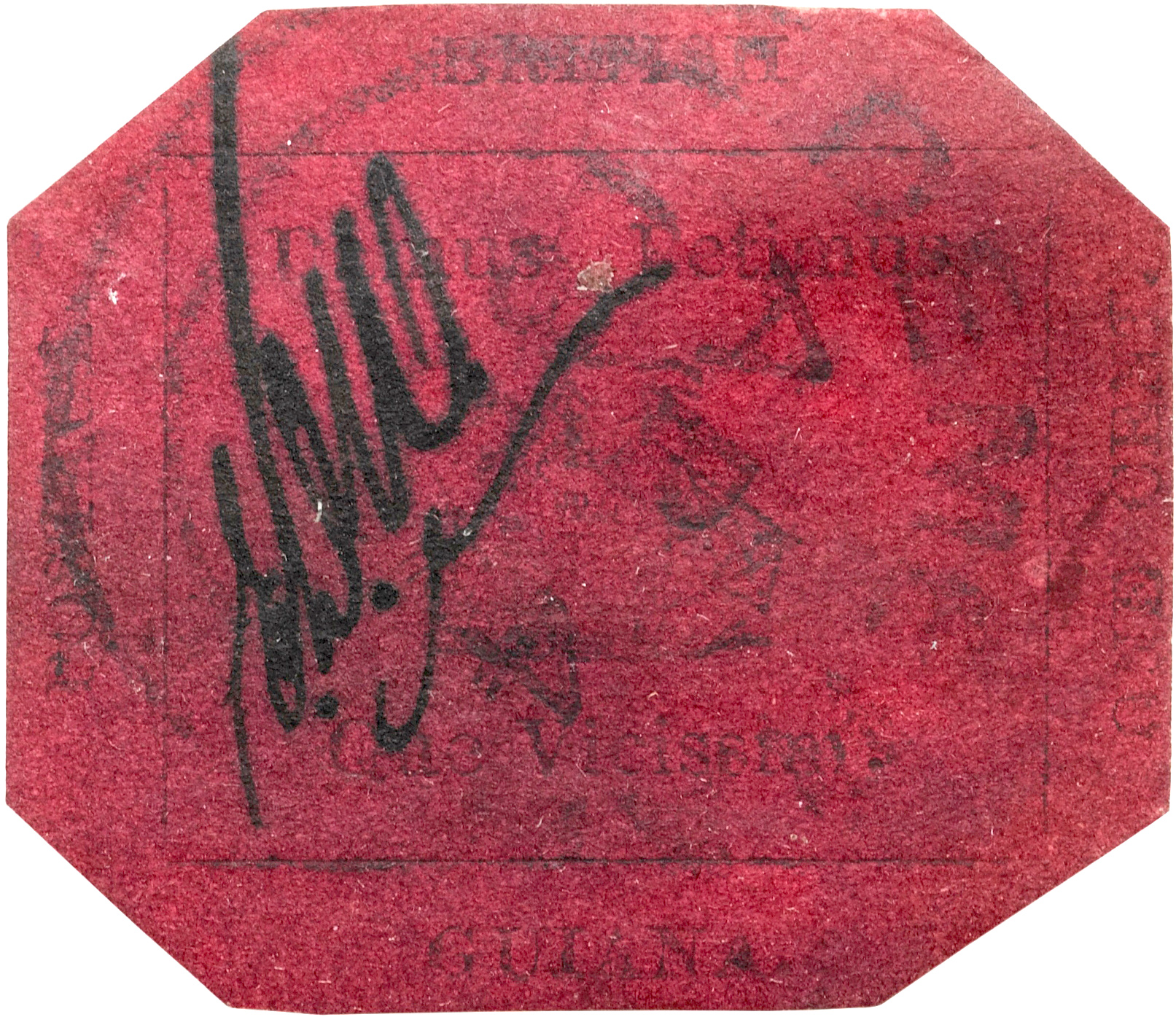
|
| The British Guiana 1c magenta stamp of Guyana 1856. MiNr.: 9, Scott: 13. |
The most famous stamp of Guyana is
the British Guiana 1c magenta which is regarded by many philatelists as the world's most famous rare stamp.
It was issued in limited numbers in British Guiana (now Guyana) in 1856,
as a part of a series of three definitive stamps and was intended for use on local newspapers.
Only one specimen is now known to exist. It is in used condition and has been cut in an octagonal shape.
The other two stamps, a 4c magenta and 4c blue, were intended for letter postage.
It is the only major postage stamp ever issued that is not represented in Britain's Royal Philatelic Collection.
It is imperforate, printed in black on magenta paper, measuring 29 x 26mm, and it features a sailing ship along with the colony's Latin
motto "Damus Petimus Que Vicissim" (We give and expect in return) in the middle.
Four thin lines frame the ship.
The stamp's country of issue and value in small black upper case lettering in turn surround the frame.
With its US$9,480,000 sale on 17 June 2014, this item broke the world record for a single stamp auction
price each of the last four times it has been sold.
In June 2021 it was purchased by stamp dealer Stanley Gibbons for US$8,300,000, after being sold at auction.
The dealer said that, gram for gram, the stamp is thought to be the most valuable man-made item in the world.
Graham Shircore, chief executive of Stanley Gibbons, called it "the Holy Grail of philately".
On arriving at Heathrow Airport, it was met by an armoured truck and gone on display at Stanley Gibbons'
shop in London in a specially commissioned, zero-oxygen frame.
[R2]
Official stamps of Guyana related to Paleontology and Paleoanthropology: dinosaurs and other prehistoric animals, fossils, paleoanthropologist
| 06.11.1990"Prehistoric creatures of South America: Cenozoic era" [1] | 10.08.1992 "Elephants" [2] | |
 |
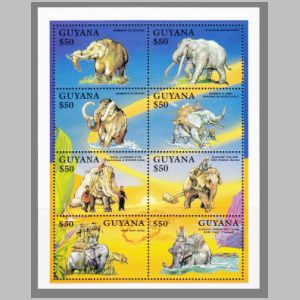 |
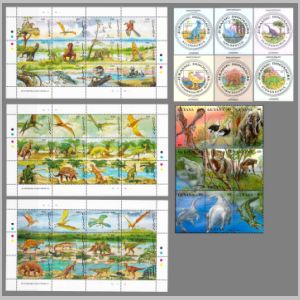 |
| 26.07.1993 "Famous persons" [4] | 23.02.1998 "Prehistoric animals" | |
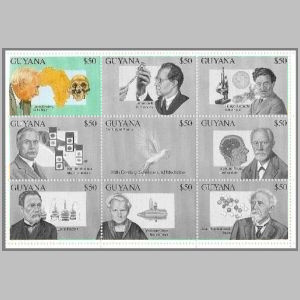 |
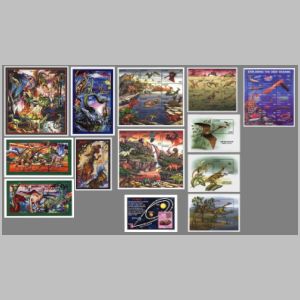 |
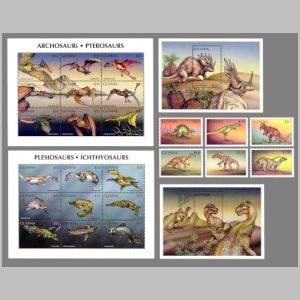 |
| 28.03.2001 "Prehistoric Creatures" | 24.01.2005 "Prehistoric animals" | 2010/2013 (?) "Definitive" [3] |
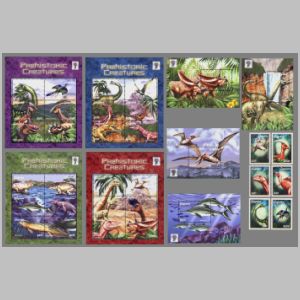 |
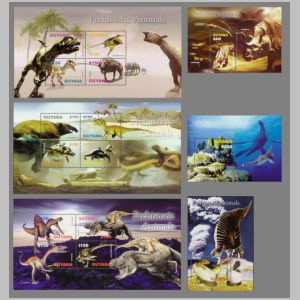 |
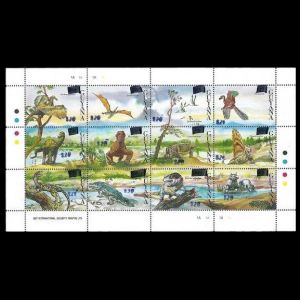 |
Notes:
[1] The first sheet of prehistoric animals ever.
[2] Mammoth and Stegodon depicted among modern elephant species.
[3] Between 2010 and 2013, Guyana issued many provisional surcharges, because the Post run out of low denomination stamps.
At least one of three Mini-Sheet with stamps of prehistoric animals from 1993 was surcharged too.
According to MICHEL stamps catalog, old values of $30 overprinted by new values of $20 with handwritten bars.
The Post of Guyana stopped surcharging when they received new low valued stamps.
The surcharged stamps were still available for sale at many post offices afterwards and can probably still be found today in remote post offices.
[4] The stamp on the top-left corner of the Mini-Sheet of "Famous persons" shows Louis Leakey who was a Kenyan paleoanthropologist and archaeologist whose work was important in demonstrating that humans evolved in Africa, particularly through discoveries made at Olduvai Gorge with his wife, fellow paleontologist Mary Leakey. Having established a program of palaeoanthropological inquiry in eastern Africa, he also motivated many future generations to continue this scholarly work. Several members of Leakey's family became prominent scholars themselves. [R3]
[5] Mars meteorite with purported fossilized bacteria.
Commemorative postmarks of Guyana related to Paleontology: dinosaur
Legend is here| 21.07.1993 "Prehistoric animals" [FDC] | ||
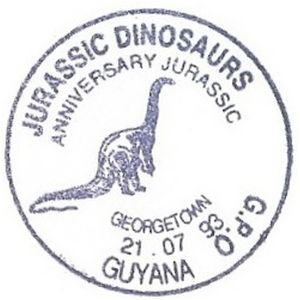 |
|
|
References:
- [R1] Guyana:
Wikipedia
WikiTravel
FlagCounter
-
[R2] Postal History and Philately of Guyana:
Wikipedia,
British Guiana 1c magenta: Wikipedia,
BBC,
Links to official website of the Post Authority, stamp catalog and a list of new stamps of Guyana are here. - [R3] Louis Leakey: Wikipedia
Acknowledgements:
-
Many thanks to Ann Wood from Guyana Philatelic Society
for help finding information about surcharged stamps.
- Many thanks to Dr. Peter Voice from Department of Geological and Environmental Sciences, Western Michigan University, for reviewing the draft page and his very valuable comments.
| << previous country | back to index | next country >> |